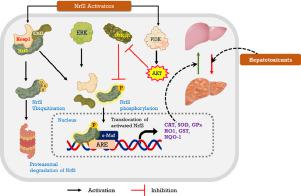Phytomedicine ( IF 6.7 ) Pub Date : 2021-09-17 , DOI: 10.1016/j.phymed.2021.153755 Ravichandran Jayasuriya 1 , Umapathy Dhamodharan 2 , Daoud Ali 3 , Kumar Ganesan 4 , Baojun Xu 5 , Kunka Mohanram Ramkumar 1

|
Background
Nuclear factor erythroid 2-related factor (Nrf2), a stress-activated transcription factor, has been documented to induce a defense mechanism against oxidative stress damage, and growing evidence considers this signaling pathway a key pharmacological target for the treatment of liver diseases.
Purpose
The present review highlights the role of phytochemical compounds in activating Nrf2 and mitigate toxicant-induced stress on liver injury.
Methods
A comprehensive search of published articles was carried out to focus on original publications related to Nrf2 activators against liver disease using various literature databases, including the scientific Databases of Science Direct, Web of Science, Pubmed, Google, EMBASE, and Scientific Information (SID).
Results
Nrf2 activators exhibited promising effects in resisting a variety of liver diseases induced by different toxicants in preclinical experiments and in vitro studies by regulating cell proliferation and apoptosis as well as an antioxidant defense mechanism. We found that the phytochemical compounds, such as curcumin, naringenin, sulforaphane, diallyl disulfide, mangiferin, oleanolic acid, umbelliferone, daphnetin, quercetin, isorhamnetin-3-O-galactoside, hesperidin, diammonium glycyrrhizinate, corilagin, shikonin, farrerol, and chenpi, had the potential to improve the Nrf2-ARE signaling thereby combat hepatotoxicity.
Conclusion
Nrf2 activators may offer a novel potential strategy for the prevention and treatment of liver diseases. More extensive studies are essential to identify the underlying mechanisms and establish future therapeutic potentials of these signaling modulators. Further clinical trials are warranted to determine the safety and effectiveness of Nrf2 activators for hepatopathy.
中文翻译:

通过生物活性天然药物靶向 Nrf2/Keap1 信号通路:对抗肝病的可能治疗策略
背景
核因子红细胞 2 相关因子 (Nrf2) 是一种应激激活的转录因子,已被证明可诱导针对氧化应激损伤的防御机制,越来越多的证据认为该信号通路是治疗肝病的关键药理学靶点。
目的
本综述强调了植物化学化合物在激活 Nrf2 和减轻毒物引起的肝损伤应激方面的作用。
方法
使用各种文献数据库,包括 Science Direct、Web of Science、Pubmed、Google、EMBASE 和 Scientific Information (SID) .
结果
在临床前实验和体外研究中,Nrf2 激活剂通过调节细胞增殖和凋亡以及抗氧化防御机制,在抵抗由不同毒物诱导的多种肝脏疾病方面表现出良好的效果。我们发现植物化学化合物,如姜黄素、柚皮素、萝卜硫素、二烯丙基二硫化物、芒果苷、齐墩果酸、伞形酮、瑞香素、槲皮素、异鼠李素-3-O-半乳糖苷、橙皮苷、甘草酸二铵、香豆素、香豆素,有可能改善 Nrf2-ARE 信号,从而对抗肝毒性。
结论
Nrf2 激活剂可能为预防和治疗肝脏疾病提供一种新的潜在策略。更广泛的研究对于确定这些信号调节剂的潜在机制和建立未来的治疗潜力至关重要。需要进一步的临床试验来确定 Nrf2 激活剂对肝病的安全性和有效性。











































 京公网安备 11010802027423号
京公网安备 11010802027423号